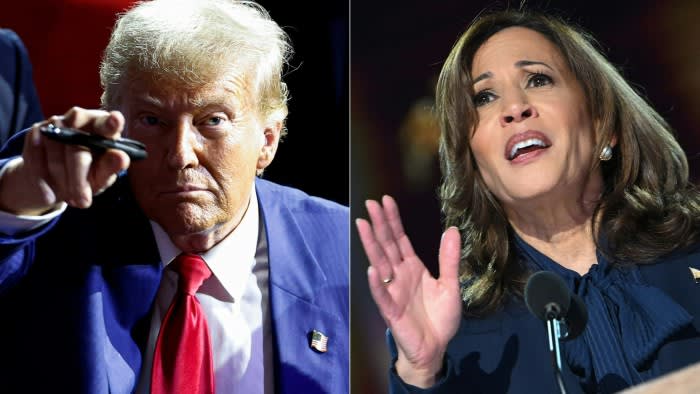Unlock the US Election Countdown newsletter for free
The stories that matter on money and politics in the race for the White House
Latest news on ETFs
Visit our ETF Hub to find out more and to explore our in-depth data and comparison tools
With less than two months to go until the US presidential election and with polls suggesting that the two leading candidates are neck and neck, it is unsurprising that some investors are getting jittery.
Newly published research from Research Affiliates, the research consultancy and investment adviser, has revealed that those nerves are familiar and translate into predictable investor behaviour.
The paper, authored by Rob Arnott, chair of Research Affiliates — which made its name developing smart beta strategies that adjust broad market indices to emphasise factors such as value — and Forrest Henslee, vice-president of research, shows that the political affiliation of the winning candidate in US elections had less bearing on markets than how close and contentious the election was.
They looked at the 24 US elections since 1928 and found that stocks in the S&P 500 tend to fall in the run-up to a close election, then surge in the final week of the campaign before continuing their upswing, albeit with greater volatility, post-election day.
“We believe this is due to fear of the outcome increasing — on both sides of the aisle — ahead of the election and then dissipating, on one side of the aisle,” the authors wrote.
They noted that after the election differences between political outcomes could be observed. So, while in the lead-up to an election, growth and value stocks tend to exhibit similar performance, after the election, value stocks tend to rebound when Republicans win the White House, while growth stocks tend to rebound when Democrats take office.
For short-term investors, therefore, the Research Affiliates findings suggest that keeping a close eye on close elections makes a lot of sense.
But there are other important messages from researchers for investors with a longer-term view. Morningstar research published in June, for example, looked at S&P 500 returns over 50 years. It found that since 1953, $1,000 invested when a Democrat is president, sold when a Republican takes office, then reinvested when a Democrat returns turns into $62,000. The opposite strategy — only investing when a Republican sits in the Oval Office — only grows to $27,000. However, doing nothing and leaving the $1,000 where it was for the duration would have reaped investors $1.7mn by the end of 2023.
However, Arnott pointed out that the Morningstar observations focused on the returns over a four-year presidential term, whereas Research Affiliates focused on the six weeks before and after an election.
He also argued that while long-term figures suggest a Democratic presidency is better than a Republican presidency for stock markets, these results are distorted by the 1929 Wall Street crash and the ensuing Great Depression, and the financial crisis of 2008 that blotted Republicans’ copybooks.
From 1860 to 1920, the opposite was the case, he said.
“Our conclusion from the mixed results is that either party can pursue policies that allow prosperity; and either party can pursue policies that crush initiative. But, this was not the point of our paper, which focused on the weeks surrounding an election,” Arnott said.
The Research Affiliates paper seems to confirm that we tend to act on our short-term hunches. A victory for Donald Trump, for example, has sparked fears in some quarters that there could be significant consequences for electric-vehicle makers and the EV battery suppliers that power them.
However, even in trying to make sectoral decisions, investors could end up wrongfooted. Financial Times columnist Stuart Kirk points out that while President Joe Biden, with his green spending and incentives, might have been expected to have been bad for extractive industries, US oil and gas companies represent the fourth-best performing domestic sector during Biden’s administration.
It might be wise, therefore, to ignore the news when checking your portfolio.
“Generally, we would caution investors against attempting to time the market based on political views or short-term patterns based on previous elections,” said Andrew Prosser, head of investments at InvestEngine, the UK ETF investment platform.
“Market-timing, especially over such short time periods, is a fool’s errand for investors, as it has proven impossible to do successfully historically. Instead, investors should keep their eyes focused on the long run,” he added.
https://www.ft.com/content/97ed22e4-1039-429c-8223-68bb67325b97


